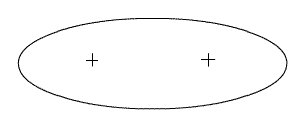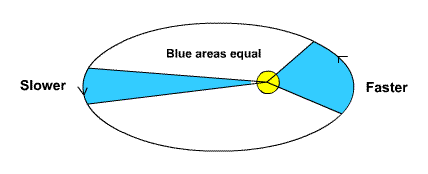|
As the Moon travels around the Earth,
you would assume it follows a circular path. In reality,
it travels in an elliptical orbit. This is true of the
planets around the Sun, as well as satellites around the
Earth and even electrons around an atom. The motion of
objects in orbit follows the rules of the Kepler's three
laws. Questions you may have include:
This lesson will answer those questions.
Ellipse An ellipse is a geometric shape
similar to an oval. It has two focus points, as seen in
the picture below.

Typical ellipse with two focus points
What is interesting about an ellipse is that if you made
a pool table in the shape of an ellipse and hit a ball
through one focus point, it would bounce off the wall
and roll through the other focus point. Likewise, if the
sides were reflective, light at one focus point would be
reflected and focus at the other point. A
circle is a special case of an ellipse where both focus
points are at the same point--the center of the circle.
Kepler's Laws In the 16th century, Polish
astronomer Nicolaus Copernicus determined that the Earth
and the planets rotate around the sun. Previously,
scientists thought everything rotated around the Earth.
Copernicus thought the orbits were circles.
Then about 75 years later, German mathematician Johannes
Kepler found that the orbits were not circles, but
ellipses. He formulated laws as to how planets and other
space objects travel when in an orbit. These became
known as Kepler's Laws. The first law is that the orbit of an
object moving around another in space is elliptical with
the stationary object located at one of the focal points
of the ellipse. In other words, the Earth
travels around the Sun in an ellipse, and the Sun is at
a focal point of that ellipse. The same is true for a
space satellite traveling around the Earth. It is
possible for a satellite to travel in a circular orbit,
but that is a special case. Kepler's second law states
that the orbiting satellite will speed up when it gets
closer to the object at the focus. This is caused by the
increased effect of gravity on the orbiting object as it
gets closer to what it is orbiting around.
The mathematical statement of the law is that the area
swept by the planet or rotating object in in giving time
is the same, independent of the distance to the object
at the focus.

Areas swept in a given time are equal
Since the areas are equal, the arc that
is further away is shorter, meaning that the speed will
be slower. This is not only true for objects in space
but also for electrons moving around the atom, as seen
in the illustration below.

Electrons moving around an atom
You can see this effect even better in the Orbit
Demonstration on the next page. This law shows the
relationship for the time required for a planet to move
around the Sun and the average distance from the Sun.
The relationship is that the time squared (t2) is
proportional to the distance cubed (d3). Thus, if you
knew the time it took to go aournd the Sun and the
distance for one planet, you could find values for
another. If t = time and d = distance for
one planet, and T = time and D = distance for another
planet, then:
t2 / T2 = d3 / D3 Calculation example
Now the time (T) it takes the Earth to go around the Sun
one time is about 365 days (1 year) and the distance (D)
the Earth is from the Sun is about 92 million miles (1
AU or astronomical unit).
Thus T = 1 and T2 = 1. Also D = 1 and D3 = 1.
Now Jupiter's distance (d) from the Sun is about 5 times
as far away or 5 AU. That means that d3 = 53 = 125. Thus
the time (t) it takes Jupiter to go around the Sun can
be calculated from Equation 1.
t2 / 1 = 125 / 1 Take the square root of
both sides of the equation, and
t = 11.2 years which is close to the
actual length of a Jupiter year. Kepler's Laws were used to
explain the orbital motion of the planets around the
Sun, as well as the various moons around the planets.
You can use the laws to calculate the speed at any
point, the time of rotation and distances for any
objects in space. They can also be applied to the motion
of electrons around the nucleus of an atom.
A good demonstration of the motion of a space satellite
around the Earth according to Kepler's Laws of orbiting
objects can be seen in the next page. You can adjust the
shape of the orbit with a slider. Kepler's three laws explain
orbital motion. The laws are: (1) Orbits are elliptical
in shape, (2) the area swept in a given time is constant
for a given ellipse, and (3) the relationship for the
time required for a planet to move around the Sun and
the average distance from the Sun is the time squared is
proportional to the distance cubed. |